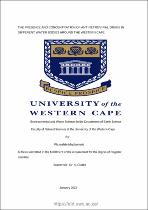| dc.contributor.advisor | Clarke, Sumaya | |
| dc.contributor.author | Maphumulo, Phumelele | |
| dc.date.accessioned | 2023-07-17T10:25:43Z | |
| dc.date.available | 2023-07-17T10:25:43Z | |
| dc.date.issued | 2023 | |
| dc.identifier.uri | http://hdl.handle.net/11394/10400 | |
| dc.description | >Magister Scientiae - MSc | en_US |
| dc.description.abstract | Concerns regarding the prevalence of chemicals from medicines and personal care goods, such as cosmetics, in streams and rivers have grown in recent years. Water quality experts and environmentalists are becoming increasingly worried about contaminants found in prescription and over-the-counter pharmaceuticals that enter various water systems. Pharmaceuticals are significant contributors to water pollution in aquatic habitats such as surface and groundwater. These contaminants are produced not only by waste materials, but also by improperly disposed of pharmaceutical items. South Africa has the world's highest rate of HIV (Human immunodeficiency virus infection) and AIDS (Acquired immune deficiency syndrome), with 8.2 million South Africans infected with HIV/AIDS, and 68% are receiving antiretroviral therapy. These medications get deposited in the environment and might reach water bodies, contaminating them. | en_US |
| dc.language.iso | en | en_US |
| dc.publisher | University of the Western Cape | en_US |
| dc.subject | Water resource management | en_US |
| dc.subject | Water pollution | en_US |
| dc.subject | Pharmaceuticals | en_US |
| dc.subject | HIV/AIDS | en_US |
| dc.subject | Public health | en_US |
| dc.subject | South Africa | en_US |
| dc.title | The presence and concentration of antiretroviral drugs in different water bodies around the Western Cape | en_US |
| dc.rights.holder | University of the Western Cape | en_US |

